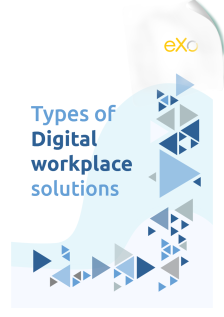
Digital Collaboration Software

Help Your Teams Connect, Collaborate and
Get Things Done
Get Things Done





At the internal level, businesses try to encourage and seek to incorporate different forms of collaboration in the workplace to lay the foundations for teams to be able to work together with an aim to achieve higher levels of success.
Externally, businesses look to engage in collaborative actions to benefit from others’ expertise, to gather the opinions of their customer base and to get customers and other stakeholders more involved in the development of products and services.
Internal collaboration involves individuals within the same team or company working together on a project to achieve certain business objectives. For this to happen successfully, employees need to be great team players with the right set of soft skills, which can be developed through corporate soft skills training. This training helps them work well in diverse, multi-skilled teams. Additionally, businesses have the responsibility to create a positive and transparent working environment where employees are encouraged to share and to input ideas and initiate collaborative actions.
One can find examples of interdisciplinary collaboration in virtually every business and industry. For example, software development is a process that requires the input of multiple teams, such as product management, design, development, QA and more. TTo keep everyone on the same page, and to organize the process and respect deadlines, these teams use a combination of best practices, methodologies (Scrum, Lean Software Development, etc.) and software solutions. They can use a digital flipbook maker to create internal communication documents and company newsletters and securely share them with the team. keep everyone on the same page, and to organize the process and respect deadlines, these teams use a combination of best practices, methodologies (Scrum, Lean Software Development, etc.) and software solutions.
Standalone or built-in project management features are ideal for managing the process and helping dedicated development team members assign and keep track of tasks. For example, some of the best ITSM software allows teams to keep track of tasks and interact with IT staff and other departments. Additionally, other functionalities, such as document management and Wikis act as knowledge repositories containing all useful information about the project. Finally, built-in messaging apps and collaborative spaces add a much needed social layer as they help facilitate meetings and give team members a private space where they can stay up to date with the latest news and updates.
We often have a tendency to associate collaboration solely with finishing projects and meeting deadlines, like in the first example. However, collaboration may also revolve around sharing knowledge and continuous learning. This is the case with collaborative communities. These can be formed within or outside an organization and allow individuals to seek help and advice to overcome specific challenges.
We can find a perfect example of collaborative communities in the healthcare industry. There are multiple internal and external communities created by doctors and healthcare practitioners, where they are able to communicate with their peers, participate in various discussions and find answers and solutions to their cases. To guarantee the security of critical data, these communities are often built on collaborative portals and extranets that are only accessible to authorized members. These platforms often contain many features, such as news and chat rooms.
By definition, a strategic alliance is an agreement (formal or informal) between two or more businesses, whether on a long or short term. Firms engaging in these alliances often do so to diversify their product offerings, mitigate risks, or gain an edge in entering new markets. This is particularly evident in sectors like building materials ecommerce, where collaborations can help businesses leverage each other’s strengths to reach new customers and streamline services.
This type of collaboration is often sought by businesses wanting to diversify their product offerings, mitigate the risks associated with penetrating new markets and to get an edge over the competition.
Some popular examples of successful alliances include Starbucks and Barnes & Noble, and Uber and Spotify/Pandora (at some stage) among others. In each example, both firms strategically targeted each other’s strengths and know-how to reach more customers and to improve their own services.
For the partnership to be successful, teams from both parties need a medium through which they can work together. Usually, when two companies form a partnership, question marks often arise over how and where the collaboration should occur.
To avoid any backlash, resistance to change and the costs associated with training staff on new software, businesses often tend to implement familiar tools that everybody knows how to use, such as email. The downside, however, is that these tools are not designed for instant communication and collaboration, often leading to more time spent locating information in endless email threads, duplicated knowledge, etc.
In recent years, more companies have started to rely on digital workplace solutions to facilitate the flow of information between them and their partners. Let’s take the example of companies A and B. Both have just recently agreed to partner and are now starting their partnership and are looking for ways to connect their teams and resources.
Company A already has a digital workplace in place, while Company B relies extensively on numerous stand-alone and specialized solutions that wouldn’t necessarily benefit the partnership. In this case, Company A can create dedicated private spaces and grant permission for Company B’s teams to join. In this way, both teams will have a common area where they can securely collaborate. This has become common practice for businesses that often outline this criterion in their digital workplace requirements specification. To streamline partnership agreements and cross-company approvals, many organizations integrate e-signature APIs into their digital workplace, enabling secure and efficient document signing between partnering firms.
Similar to strategic alliances, supply chain collaboration involves two or more businesses that share, more or less, the same objectives. It is usually centred around optimizing costs, speeding up the time to market and maximizing business value.
Supply chain collaboration can be either horizontal or vertical. Horizontal collaboration occurs between two or more parties from the same level of a supply chain (e.g., two companies within the same industry), while vertical collaboration involves parties from different levels (e.g., a wholesaler and retailer).
As supply chains nowadays can consist of multiple global players, the need for collaboration has grown significantly. Let’s take the example of a typical retail supply chain. As the goods make their way from the vendor to the end customer, they need to be processed and transported through several other levels, such as distribution centres, warehouses and stores. This is a complex process that requires a constant flow of information to keep everyone aligned and able to meet delivery times.
In order to find the right type of collaboration for your business, you have to follow a strategic approach and answer three common yet critical questions: Where are we? Where do we want to be? And how do we get there?
It is worth noting, however, that finding the right collaboration type is not a one-size-fits-all process. The answers to those three questions will differ between businesses, based on multiple factors such as the industry, size, and company policies, among others.
Answering the first question will help you to generate an overall idea about the state of collaboration in your business. For that, you would have to carry out one-on-one or group interviews with team managers and employees, which will give you an overview of how they collaborate every day, the tools they use, and what they need to move forward. For example, if you were choosing a top-rated branding agency to collaborate with your business, you’d have to make sure they would deliver on their promises.
The second question revolves more around the vision and objectives, both short and long term. For example, a business that has just shifted its operations to fully remote as a result of the ongoing COVID-19 pandemic will obviously look to foster remote collaboration and eliminate communication silos. It will also look to form partnerships and restructure its supply chain.
This leads us to the third and most important question: How do we get there? For example, how do we foster collaboration while working remotely? Or how do we make our supply chain more effective?
On the external level, and taking into consideration the events of the last year or so, strategic partnerships and supply chain collaboration have taken a central role in ensuring the continuity of many businesses.
In summary, collaboration in the business world takes a variety of shapes and forms and involves multiple stakeholders.
For many businesses, the key to growth and continuous success is the ability of the business to lay the foundation for effective collaboration and to set up the right strategy and tools taking in consideration the specific characteristics of their wokforce. In the next blog post in this series, we discuss how to create and promote a collaborative culture. Stay tuned!

Types of Digital workplace solutions
Digital workplace is a buzzword these days. Actually different people use it to mean different things. So what is a digital workplace?



You will find here Frequently Asked Questions about collaboration with all the answers in one place.
Collaboration is “the situation of two or more people working together to create or achieve the same thing”.
Here are some definitions of digital workplace:
In order to effectively find the right type of collaboration for your business, you have to follow a strategic approach and answer three common yet critical questions: Where are we? Where do we want to be? And how to get there?
At the internal level, businesses try to encourage and seek to incorporate different forms of collaboration in the workplace to lay the foundations for teams to be able to work together with an aim to achieve higher levels of success.
Externally, businesses look to engage in collaborative actions to benefit from others’ expertise, to gather the opinions of their customer base and to get customers and other stakeholders more involved in the development of products and services.
Here are some of the benefits of collaboration in the workplace:
( Your e-mail address will not be published)
Totally agree! Thanks for sharing your thoughts on collaboration and understanding one another 🙂
I like those ideas about the importance of collaboration. I will share this to the youth I am handling with.
Very helpful !
Collaboration is a key factor for a successful business.
The most important thing is to know how to develop collaboration in work teams
Collaboration brings productivity and engagement.
Collaboration is important because you can you promote your internal and external communications. If you don’t really collaborate you cant get a lot of thing done in your business or even in your daily life.
I think that collaboration is important because it helps you work together and communicate to each other when you work on something with someone and it helps you better understand on what you are doing as you work together.
To launch Collaboration at your workplace, start with new employees.
I think new hires are more of a building blocks on a company.
Good article and gave a lot of important information.
Thank you for sharing this thought.
I will help share the content of this important article.
Very interesting 😉 Although of course I knew the simple definition of “collaboration” this guide provided good details for use as a tool going forward.
Admiring the dedication you put into your blog and detailed information you present.
I think what you published made a lot of sense.
This article Totally reminds the reader the importance of collaboration especially as we are virtual with respect to boosting morale, opening more channels of communication, and hopefully leading to higher retention and employee engagement
Wonderful article.
It’s always beneficial to collaborate. It opens your eyes to new experience and different perspective of doing things. I always experience the same during my work when I try solving problems.
Excellent post. Is there any other benefits to be considered?
It is wrong to think that nothing depends on you. But it is far more wrong to think that it does not impact you what others do. So, humankind is social, much deeper than anyone thinks. Therefore, collaboration is a very normal approach to moving forward in their short lives.
Great article !
So what unintentionally prevents employees from freely collaborating within a company?
Collaboration is important because we can share knowledge and experience.
“If you want to go fast, go alone. If you want to go far, go together.”
collaboration is very important to learn new social skills
Aw, this was an extremely nice post.